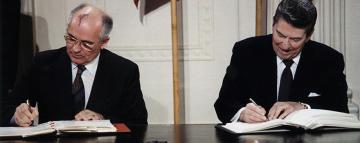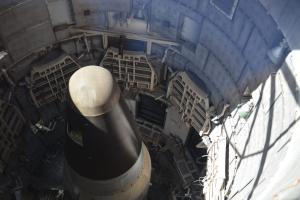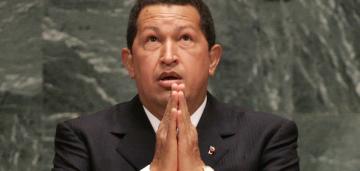The late Ronald V. Dellums shows us how to fight against the Pentagon-inspired madness of military spending and nuclear proliferation.
In our final post of 2024 for The Black Agenda Review republished Sonia Sanchez’ powerful 1982 poem for peace and disarmament, “Reflections after the June 12th March of Disarmament.” In the poem, Sanchez calls for a halt not only to “nuclear proliferation, nuclear plants, nuclear bombs, nuclear waste” but also to “the proliferation of nuclear minds….” For our first post of 2025, we reprint a 1983 essay from the late Ronald V. Dellums that can be seen as an extension of Sanchez’s poem. Titled “Unconscionable Costs,” and first published in the Democratic Left magazine, Dellums not only argues against nuclear proliferation, but he puts a price tag on unchecked and ballooning military spending.
Dellums notes that US military spending in the first year of the Carter administration was under $100 billion; it was close to $200 billion by the time Carter left office. Reagan, in his first term in office, immediately increased military spending to $226.3 billion as part of a five year project of increased military spending. Dellums writes: “A recent study by the Congressional Budget Office indicated that, at present growth/inflation rates, we may well be spending $422 billion a year on the military by 1987.”
Elected in 1971, Ron Dellums was the first Black person to represent Northern California in the US Congress. Though he ran on the Democratic Party ticket, Dellums openly identified as a socialist. Over almost three decades as a member of Congress, Dellums advocated for an inquiry into US war crimes in Vietnam, was the first to introduce legislation to impose sanctions on apartheid South Africa, and consistently fought against US foreign invasions (Grenada in 1983, Panama in 1989, Iraq in 1991). Arguably most significant was Dellums’s fight against US military spending and the ballooning US military budget. For Dellums, opposition against military spending was about more than the costs. He fought for both a US policy of nonintervention and “nuclear and conventional arms reductions” by “both superpowers and their NATO and Warsaw Pact allies.” Dellums wanted the “total elimination of all crisis-destabilizing nuclear weapons systems.”
Dellums had no illusions about the possibilities for the success of his proposals and he admits they ultimately failed. But what is inspiring to us is that Dellums provides an alternative to “the Pentagon-inspired madness” of U.S. military budgets, especially now, at a moment when such madness is cast as sanity.
It is January 2025, and the US empire, drunk on its own power– and certainly aware of its inevitable demise–is pushing us closer and closer to nuclear war. The military budget that Dellums fought so hard to limit has exploded: in 2024, it was $849.8 billion—not including billions of dollars in supplemental military aid to Ukraine, Israel, and Taiwan.
Today, there is no one like Ron Dellums in Congress. The last member of congress to protest against war was Dellums’ successor, Barbara Lee in 2001. Now, the Congressional Black Caucus that he helped found is full of neocon militarists such as the warmongering zionist and genocide supporting supercoon Hakeem Jeffries. As the world collapses around them, the Black misleadership class greedily feeds on the US empire's rank, fetid entrails. The times are dire. Yet Dellums’s essay shows us how to fight for peace while the world is at the brink of war. We reprint Ronald V. Dellums’ “Unconscionable Costs” below.
Unconscionable Costs
Ronald V. Dellums
Since 1945, American foreign and military policies have been predicated on a series of hypotheses, revolving around the basic theme of preserving the “national security” of the United States. Eight successive presidents have contended that the cornerstone of this policy must be an unrelenting response at all levels to the alleged Communist crusade for “global hegemony” and the defense and maintenance of the “Free World. ” Thus,with the passage of time, the purported “vital” “national security” interests of the United Stated have assumed global dimensions. Both Democratic and Republican administrations have repeatedly sought, through covert or overt intervention, military solutions to international problems that are essentially political, economic, social or cultural in origin.
This “national security” psychosis has made possible the evolution of a permanent war economy that has made the United States, because of its superior technology, the principal force in global arms escalation, both nuclear and conventional. It was a Democratic administration, headed by President Harry S. Truman, that tripled the military budget in 1950. It was a Democratic administration, headed by John F. Kennedy, that first proclaimed a missile gap with the Soviet Union when it knew the opposite was true, and then brought the planet to the verge of a nuclear holocaust during the Cuban Missile Crisis in 1962.
It was a Democratic administration, headed by Jimmy Carter, that prepared and began to implement the notorious Presidential Directive 59, which opened the way to discussion of a first-strike strategy.
In 1977, when the Carter administration assumed office with a pledge, to reduce military spending by $5-$7 billion in its first year, the total military budget was slightly less than $100 billion. Four years later it was $173 billion, but Carter left office asking for a further increase to $194 billion. The Reagan administration immediately raised that figure to $226.3 billion, as part of a five year-military spending projection of $1.6 trillion. Because of cost-overruns and projected supplemental appropriations, that figure has already been raised to $2.3 trillion for the same period. A recent study by the Congressional Budget Office indicated that, at present growth/inflation rates, we may well be spending $422 billion a year on the military by 1987.
The dimensions of disaster being plotted by the Reagan administration almost defy any rational analysis, as Robert Scheer discovered when researching and interviewing for his excellent new book: With Enough Shovels: Reagan, Bush and Nuclear War. The Reagan administration has consciously and deliberately moved beyond the strategy of deterrence to one that proposes to fight, survive and “win” a nuclear war.
When he was Secretary of Defense in the Kennedy administration, Robert Strange McNamara defined deterrence as the capacity to destroy 30 percent of the Soviet society's population and 70 percent of its economic infrastructure. He felt this objective could be achieved through the use of approximately 400 strategic nuclear warheads. In 1983, the U.S. possesses more than 10,000 strategic warheads in its nuclear arsenal, plus 15,000 more of intermediate range for theater nuclear use. At present, it is estimated that there are approximately 886 cities and towns in the U.S.S.R. with a population of 25,000 or more people. How much is enough?
The Reagan administration is committed to developing nuclear weapons that go beyond our capacity to verify or control. In past years the necessity for verifiability and control have been integral elements of all previous arms control agreements and negotiations. The development of first-strike nuclear weapons such as the MX Missile (cynically christened the “Peacekeeper” by the Great Communicator [Ronald Reagan]), the Pershing II Missile, the Trident D (D-5) Missile, and ground-, sea- and air-launched Cruise missiles ushers us into a new era of the nuclear arms race, one that drastically reduces the prospects for a meaningful nuclear arms freeze and subsequent mutual-balanced force reductions of both nuclear and conventional weapons.
It was in this context that, in January of 1982, I mounted a comprehensive legislative challenge to the policy assumptions and spending priorities of the Pentagon and the White House. Two days after the President's State of the Union message, I formally petitioned Representative Mel Price of Illinois, the Chair of the House Armed Services Committee, to expand the Committee's hearings on the military budget in order to examine a broader spectrum of policy issues and economic factors relating to the military budget. The Committee informed me that it had deadlines to meet, and could not afford the time.
In response, I decided to convene the Special Congressional Ad Hoc Hearings on the Full Implications of the Military Budget. After raising the necessary funds from various peace groups, which also ensured the hearings being broadcast on the Pacifica Radio Network, my staff and I invited more than forty expert witnesses to testify.
For six days during March and April, a number of concerned congressional colleagues and I conducted an in depth examination of the military budget from the perspectives of foreign policy and national security implications, escalation v. disarmament, economic implications, moral implications, citizen responsibilities in challenging the military budget, and the impact of global arms sales.
The witness list ranged from J. William Fulbright, Chairman of the Senate Foreign Relations Committee during the Indochina War era to social policy analyst Frances Fox Piven to Catholic Bishops Walter Sullivan of Richmond and John Quinn of San Francisco. Several witnesses were DSA members.
After studying more than 1,800 pages of transcript testimony, my staff and I met with defense analysts and budget experts to draft a comprehensive alternative military budget. After Congressional Budget Office verification of the accuracy of our dollar figures and program projections, I introduced H.R. 6696. The peace community, in and out of the Congress, was surprised when, in an unprecedented ruling, H.R. 6696 was designated by the House Rules Committee as the official substitute for the House Armed Services Committee bill (H. R. 6030).
Thus, on Tuesday, July 20, 1982, for the first time in the history of the Cold War, the U.S. Congress debated a comprehensive legislative alternative to the Pentagon-inspired madness that has persistently prevailed. During the course of the extended debate I formally proposed a military budget based on the policies of nonintervention, nuclear and conventional arms reductions, a mutual reduction of forces by both superpowers and their NATO and Warsaw Pact allies, and a rejection of the doctrine of nuclear superiority in favor of nuclear sufficiency. I proposed the total elimination of all crisis-destabilizing nuclear weapons systems, such as the MX Missile, the Pershing II Missile, all sea- and ground-launched Cruise missiles, the Trident II (D-5) Missile, and neutron weapons. I also proposed the elimination of chemical warfare weapons, and such obsolete or useless conventional weapons systems as the B-l Bomber, the XM-1 tank, the two nuclear carriers proposed in the Defense Department authorization bill, the Aegis Missile Cruiser program, and the retrofitted battleships.
Few people are aware that the research, development, production and deployment of our current and proposed nuclear arsenal constitute only 21 percent of the overall military budget. The remainder is for conventional forces, maintenance overhead and personnel costs. Accordingly, I proposed an initial 5 percent reduction in all U. S. military personnel as a first step toward mutual troop reductions. To reduce further the possibility of U.S. intervention in the Third World, I also proposed the total elimination of the Rapid Deployment Force and the incremental reduction of the U. S. Navy fleet to approximately 400 vessels (the administration has proposed that the surface fleet be increased to 640 vessels).
This alternative proposal would have reduced the Pentagon's budget authority by more than $50 billion in the first year alone. More important, it set the stage for continued cuts in nuclear and conventional weapons systems and in personnel, while establishing stringent oversight controls for waste, fraud and abuse. Within three years, such cuts and controls could reduce the annual federal deficit by more than 60 percent.
Even though it was defeated, its opponents treated it as a serious challenge to the status quo. Many of those who opposed it did so in statements of rebuttal drafted with the direct assistance of the Pentagon and the Armed Services Committee staff. They know that they have not seen the last of it. As I said on the House Floor after the formal debate: “We will be back next year and the year after that and the year after that until we right the wrongs in this madness.”
(The National Executive Committee of DSA has adopted a resolution supporting H.R. 6696, which will be re-introduced in Congress. Proposals will be made at the February board meeting for actions that locals can take to support the bill).
Where do we go from here? We in the progressive community need to develop a coherent, cohesive strategy and program for challenging the military budget in 1983.
One of the more disturbing realities of American political life is that most of its political leaders, regardless of ideology or geographical origin, function most comfortably in an atmosphere of ambiguity, one in which pragmatism takes precedence over principle. The “liberal” and “moderate” will temporize, saying that change must proceed slowly, so we must consider transferring funds from nuclear to conventional forces. When pushed, they will vote for a Nuclear Freeze Resolution (H.R. 521), and even to defer funding for an MX basing mode. But they will not vote for a comprehensive alternative military budget (H.R. 6696), or to terminate all funds for the MX Missile, because such proposals are considered “too radical.” Thus the Freeze resolution could garner 202 votes of congressional concern, but the alternative military budget received only 55 votes. The latest proposal to defer funds because of the failure to develop a basing mode for the MX Missile secured 245 votes, but repeated attempts to delete all funds for the MX Missile program have never obtained more than 96 votes in the House.
Why? Because these proposals are “too radical”? On the contrary, I would argue that “radical” politics is the truly progressive position. The progressive platform must be that which proposes new alternatives that minimize the risk of nuclear war by advocating policies of peace that mean not only the absence of war, but the absence of conditions in the world which create international hostility and confrontation. That is why we must go beyond the concept of a Nuclear Freeze to an all-out sustained challenge to the administration’s military budget and the policy assumptions that are used to justify it.
We need an orchestrated national effort at every facet of the community level to mobilize, energize and organize citizens around the economic, political, and biological dangers they face because of this unrestrained military budget.
As progressives we have a special responsibility to our fellow citizens at this critical moment in history, to do so, we must reach out to every segment of our society to build this coalition of peaceful challenge and change. Nuclear weapons are equal opportunity destroyers—we must become equal opportunity coalition builders.
Ronald V. Dellums, “Unconscionable Costs,” Democratic Left 11 no. 1 (January 1983)
















